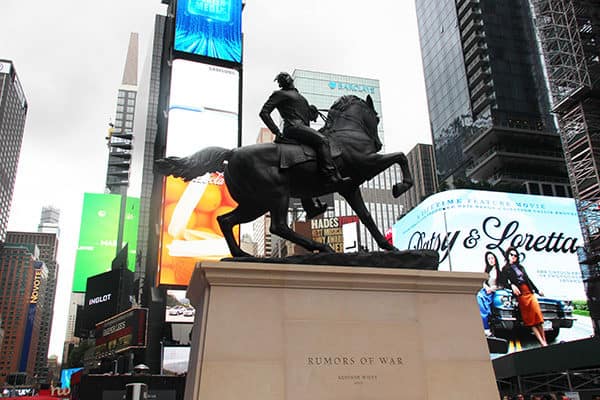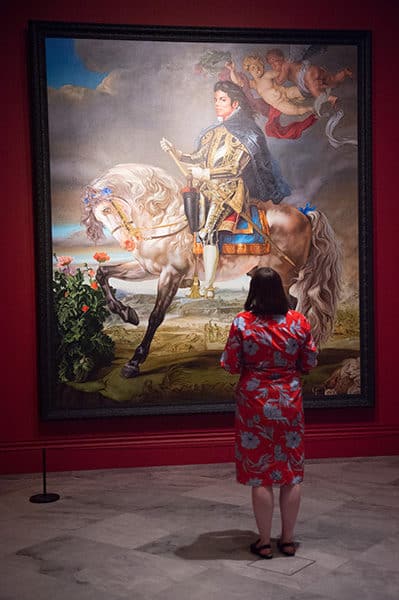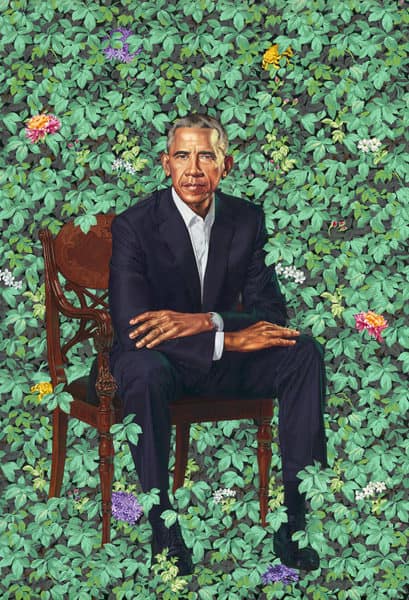Times Square has a new statue. Kehinde Wiley’sRumors of War is an eight-ton, 29-foot-high equestrian sculpture of a black man. He has dreadlocks and wears a hoodie, Air Jordans, and earphones.
It’s deliberate mockery of Confederate monuments. Mr. Wiley modeled his sculpture after J.E.B. Stuart’s statue in Richmond, Virginia. Soon, Rumors of War will be permanently located there, a short distance from Monument Avenue, with its memorials to Stuart, Robert E. Lee, Jefferson Davis, and other Confederate heroes. Mr. Wiley says he feels “dread and fear” when he sees them.
In the middle of New York’s Times Square, Kehinde Wiley, has set up a sculpture of an Afro-American man on a horse. (Credit Image: © Christina Horsten/DPA via ZUMA Press)
“What does it feel like physically to walk a public space and to have your state, your country, your nation say, ‘This is what we stand by’?” Mr. Wiley asked at his statue’s unveiling. “No! We want more. We demand more.” He said his statue symbolized saying “yes to something that looks like us.” It was also about “inclusivity,” and “broader notions of what it means to be an American.”
The unveiling was a lavish affair, featuring the Malcolm X Shabazz High School marching band and several enthusiastic speakers. Times Square Alliance president Tim Tompkins said Mr. Wiley is “one of the greatest artists of our time,” who has created something that “speaks to the intersection of beauty, power, privilege, and violence in our society.” Times Square, he said, is a “chaotic, diverse and democratic space,” and the statue will allow visitors to “see ourselves and our society in new ways, to ask difficult questions and in this place of free speech, to speak to the issues of our time.”
In December, the statue will be moved to its permanent home outside the Virginia Museum of Fine Arts during the 400th anniversary year of the arrival of the first African slaves in British America.
“We are all about inclusivity, accessibility, and relevance,” Virginia Museum of Fine Arts director Alex Nyerges said at the Times Square unveiling. He praised a “grand, majestic work of art” that is “making this day a day of rebirth, so that we can work through and eliminate racism, hatred, all the things that bring our world down.”
Mr. Wiley and his supporters are right. The statue represents a “rebirth.” Leftist activists topple Confederate heroes, cover the Founding Fathers, and desecrate Christopher Columbus. A new non-white America needs new non-white statues.
Mr. Wiley is perfect for the task. His work is almost entirely derivative. Much of it consists of simply replacing white men with black figures. Often, he doesn’t even do the painting himself.
In his Napoleon Crossing the Alps, Mr. Wiley replaced the Emperor with a young black man wearing camouflage, a bandanna and Timberland boots.
In one painting, Mr. Wiley replaced King Philip II of Spain with Michael Jackson. The black pop singer, dressed in 16th century armor, sits astride a horse. Angels crown him with a laurel wreath. The absurd piece clearly mocks European art.
A woman stands in front of a portrait titled ‘Equestrian Portrait of King Philip II (Michael Jackson)’ by Kehinde Wiley. (Credit Image: © Justin Ng/Retna/Avalon via ZUMA Press)
In his Judith and Holofernes paintings, Mr. Wiley (or his assistants) painted Judith as a black woman holding the decapitated head of Holofernes, depicted as a white woman. The story of Judith and Holofernes inspired generations of European painters. Now, it’s an expression of black resentment, thanks to Mr. Wiley’s cultural appropriation.
That Obama artist, Kehinde Wiley, is also know for these fun paintings, which you can file under
“Imagine if this showed a TKTK ” pic.twitter.com/4M0Tg1rZSG
— Jon Levine (@LevineJonathan) February 12, 2018
Mr. Wiley also painted Barack Obama’s official White House portrait. Many ridiculed his cartoonish creation. Its silliness implicitly degraded President Obama’s predecessors, dragging their dignified representations down to Mr. Wiley’s level.
Mr. Wiley tells us his purpose is to take “the great heroic, often white, male hero” and then “weaponize and translate it into a means of celebrating female presence.” When he studied classical painting, the homosexual artist drew nude white women. Now he uses the same techniques to depict his own people. “It was a return home,” he says in the same interview.
“I wanted to come to terms with the spectre of blackness as something that as society we’ve been dealing with for a long time,” Mr. Wiley told The New Yorker in 2018. “Color is coded, and the way that blackness figures in our history is something that’s fascinating to me.”
His “weaponized” art fits the message elites want to promote. It’s not surprising he enjoys favorable press.
Yet Mr. Wiley’s work is innocent compared to other “public art” being created in the post-Western world. White American Cleon Peterson often creates images of black figures torturing and murdering whites.
One painting shows three blacks assaulting three whites. One stabs a white man, another threatens a nude white woman with a knife, another stands guard over a bound white woman. A vandalized classical statue signifies blacks’ conquest of white culture.
Another painting, a crude power fantasy, depicts black police rampaging through a city street brutalizing whites. One black officer urinates on a prostrate white woman. In another painting called Pissers, two black cops pin down and urinate on a white man.
These disturbing images apparently convinced the Eiffel Tower’s management to give Mr. Peterson the honor of designing the first mural at the tower’s base. What’s next, a statue of a black gangbanger standing over a Confederate general?
Our rulers are removing heroic depictions of white men and replacing them with celebrations of black power. This reflects their image of America. They truly appear to believe that this country is for non-whites, and now art must reflect this.


